Mastering Your Life: The Ultimate Guide to Taking Charge of Your Future
Mastering Your Life: The Ultimate Guide to Taking Charge of Your Future
Welcome, dear reader, to the one-stop shop for mastering your life and taking charge of your future! Think of this as your personal treasure map, but instead of gold doubloons, you’re after something far more valuable: a life of success, control, and unwavering awesomeness. Buckle up, because we’re about to embark on a journey filled with humor, wit, and solid, fact-driven advice.
Personal Development Skills: Because Adulting is Hard
Time Management: The Secret to More Netflix Time
Time management isn’t about becoming a robotic productivity machine; it’s about finding time for the things you love. Mastering time management means prioritizing tasks like a pro, setting realistic goals, and scheduling your day efficiently. Imagine having so much free time that binge-watching an entire Netflix series in one sitting doesn’t give you guilt-induced insomnia. It’s possible, my friend.
Self-Discipline: Your Inner Drill Sergeant
Self-discipline is like having a strict but loving drill sergeant in your head. It’s about staying focused and motivated, even when your couch is whispering sweet nothings. Studies show that self-disciplined individuals are more likely to achieve long-term goals and experience greater satisfaction in life. So, put down that third donut and get back to work!
Emotional Intelligence: The Jedi Mind Trick of Adulting
Emotional intelligence (EI) is the Jedi mind trick of adulting. It involves understanding and managing your emotions while also being able to read and influence the emotions of others. High EI can lead to better relationships, improved communication, and less workplace drama. Use your EI powers wisely, young Padawan.
Adaptability: Darwin Would Be Proud
Charles Darwin didn’t say, “Survival of the strongest,” he said, “Survival of the most adaptable.” Adaptability is your ability to roll with the punches, embrace change, and adjust your plans as needed. Whether it’s a global pandemic or a last-minute project change, adaptability is your ticket to staying ahead.
Resilience: Bounce Back Like a Superball
Life will knock you down. It’s inevitable. But resilience is what helps you bounce back, stronger and wiser. Building resilience means developing coping strategies, maintaining a positive outlook, and learning from setbacks. Remember, every superhero has their origin story of struggle and triumph. This is yours.

Professional Skills: Climbing the Corporate Ladder (Without Stepping on Toes)
Communication: The Art of Not Being Misunderstood
Effective communication is the cornerstone of any successful career. Whether it’s verbal or written, clear communication can prevent misunderstandings, resolve conflicts, and build stronger relationships. If you’ve ever had an email misinterpreted, you know how crucial this skill is. Pro tip: Emojis can sometimes help convey tone. 😊
Leadership: More Than Just Bossing People Around
Leadership isn’t about wielding power; it’s about inspiring and guiding others. Good leaders motivate their teams, set clear goals, and foster a positive work environment. According to Harvard Business Review, companies with strong leadership outperform their competitors. So, next time you’re in a team meeting, channel your inner Captain America.
Problem-Solving: Your Inner Sherlock Holmes
Problem-solving is your ability to analyze situations, identify issues, and come up with effective solutions. It’s like being Sherlock Holmes but without the deerstalker hat (unless that’s your thing). Companies value employees who can think on their feet and tackle challenges head-on. So, sharpen those deductive reasoning skills and get ready to impress.
Negotiation: The Art of Getting What You Want
Negotiation isn’t about being a bulldozer; it’s about finding mutually beneficial agreements. Whether you’re negotiating a salary increase or a business deal, good negotiation skills can lead to better outcomes. According to a study by Harvard Law School, effective negotiators are often better communicators and more empathetic. So, next time you’re haggling, remember: it’s not about winning, it’s about finding common ground.
Networking: Your Personal Spider Web
Networking isn’t just for extroverts or LinkedIn junkies; it’s for anyone looking to build professional relationships. A strong network can open doors to opportunities and provide support when you need it. According to LinkedIn, 85% of all jobs are filled via networking. So, put on your best smile, attend that conference, and don’t forget to follow up.
Technical Skills: Because We’re Living in a Digital World
Digital Literacy: Keeping Up with the Kids
In today’s tech-savvy world, digital literacy is essential. Staying updated with current technology trends and tools relevant to your field can give you a competitive edge. Whether it’s mastering new software or understanding cybersecurity basics, being digitally literate is crucial. Remember, if a toddler can navigate an iPad, so can you.

GET YOUR FREE ONLINE BLUEPRINT:
www.digitalpronow.com
Financial Literacy: Making Cents of It All
Financial literacy is about understanding financial principles, managing personal finances, and making informed investment decisions. It’s like having a superpower that helps you avoid debt traps and build wealth. According to a FINRA study, individuals with higher financial literacy are more likely to have an emergency fund and less likely to carry high-interest debt. So, grab a finance book and start learning.
Project Management: Herding Cats, Like a Pro
Project management skills are essential for planning, executing, and completing projects efficiently. It’s about setting clear goals, defining roles, and keeping everyone on track. According to the Project Management Institute, organizations with mature project management practices are more likely to meet their goals. So, next time you’re feeling overwhelmed, remember: it’s all about breaking it down into manageable pieces.
Data Analysis: The Sherlock Holmes of Spreadsheets
Data analysis is your ability to interpret data and use it to inform decisions and strategies. In a world driven by big data, this skill is invaluable. Whether it’s sales figures or website analytics, being able to analyze data can lead to more informed decisions. Remember, numbers don’t lie, but they do need interpretation.
Marketing and Sales: The Art of Persuasion
Marketing and sales skills are about understanding your audience and effectively promoting your products, services, or personal brand. It’s not about being pushy; it’s about being persuasive and understanding what your audience needs. According to HubSpot, businesses that prioritize marketing and sales alignment achieve 38% higher sales win rates. So, brush up on those marketing strategies and start selling like a pro.
Life Skills: Because You’re More Than Your Job

Take Your Business To The Next Level
Answer these 30 questions and we’ll send you a personalized report
This Scorecard has been designed to show entrepreneurs, startups and small businesses their blind spots and provide instant, actionable steps on how to improve
- It takes just 2 minutes
- It’s completely free
- Receive customised results instantly
Health and Wellness: Because Your Body is Your Temple
Prioritizing physical and mental health is crucial for a successful life. Regular exercise, a balanced diet, and stress management techniques can improve your overall well-being. According to the World Health Organization, regular physical activity reduces the risk of many health issues, including heart disease and depression. So, put on those running shoes and take a mental health day if you need it.
Critical Thinking: Question Everything
Critical thinking is your ability to think clearly, rationally, and independently. It’s about questioning assumptions, analyzing information, and making well-informed decisions. According to a study by the University of Melbourne, individuals with strong critical thinking skills are better problem solvers and more successful in their careers. So, next time someone tells you something, don’t just take it at face value. Analyze, question, and think critically.
Creativity: Think Outside the Box
Creativity isn’t just for artists; it’s for anyone looking to innovate and solve problems in new ways. Encouraging creative thinking can lead to breakthroughs in both personal and professional life. According to a study by Adobe, businesses that invest in creativity see higher revenue growth. So, let your imagination run wild and think outside the box.
Decision-Making: Choose Wisely
Good decision-making is about making informed and timely choices. It involves weighing options, considering potential outcomes, and making the best choice with the information available. According to a study by McKinsey & Company, organizations with effective decision-making processes are more likely to outperform their peers. So, next time you’re faced with a tough decision, take a deep breath, weigh your options, and choose wisely.
Learning Agility: The Growth Mindset
Learning agility is about having a growth mindset and the ability to learn quickly from experiences. It’s about being curious, open to feedback, and willing to learn from mistakes. According to a study by Korn Ferry, individuals with high learning agility are more likely to be promoted and succeed in leadership roles. So, stay curious, keep learning, and embrace the journey.
Your Future Awaits
There you have it: a comprehensive guide to taking control of your life and achieving success. By developing these personal, professional, technical, and life skills, you’ll be well-equipped to navigate any challenges and seize opportunities that come your way. Remember, success isn’t about being perfect; it’s about being prepared, persistent, and willing to learn and grow. So, go forth and conquer, because your future awaits!





